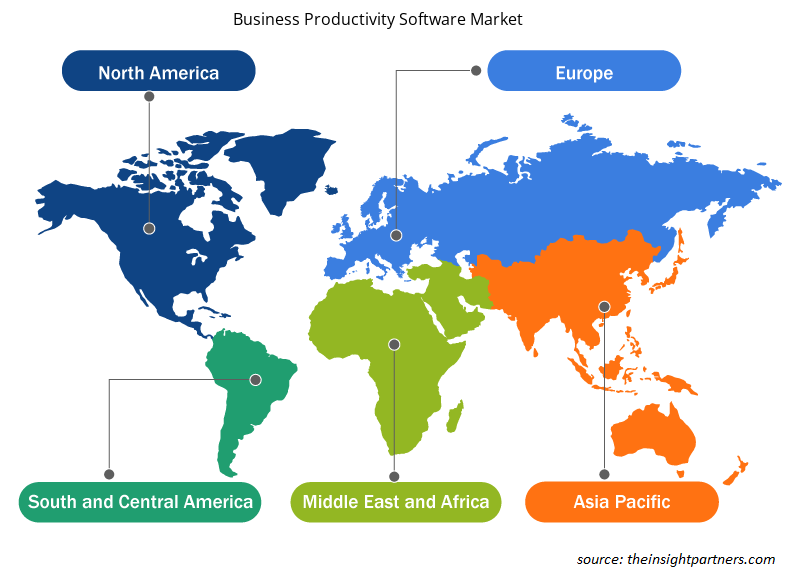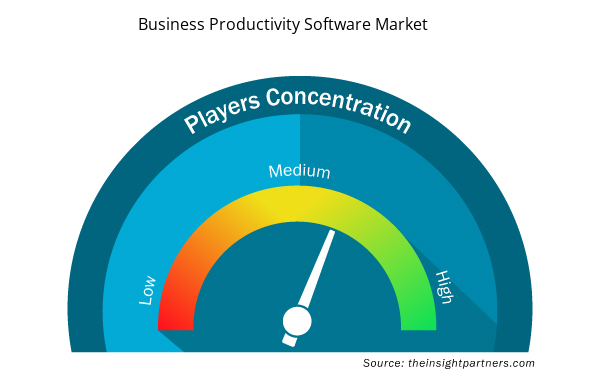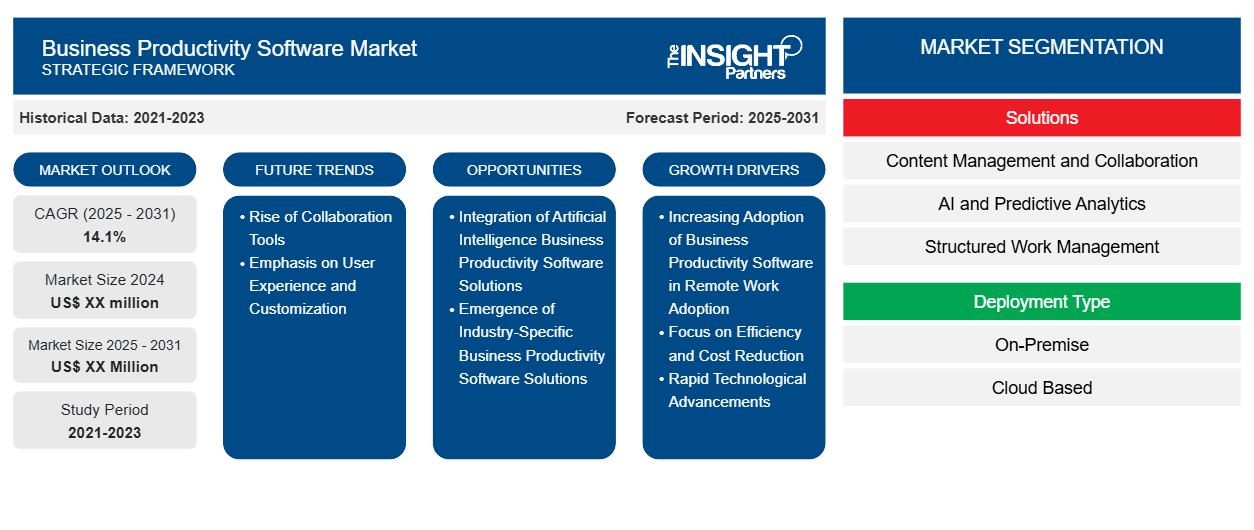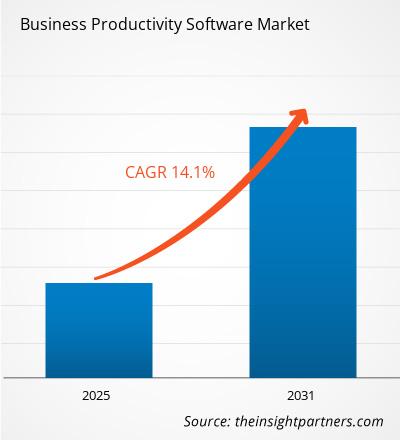من المتوقع أن يسجل سوق برمجيات إنتاجية الأعمال معدل نمو سنوي مركب بنسبة 14.1٪ من عام 2023 إلى عام 2031، مع توسع حجم السوق من XX مليون دولار أمريكي في عام 2023 إلى XX مليون دولار أمريكي بحلول عام 2031.
تم تقسيم التقرير حسب الحلول (إدارة المحتوى والتعاون، والذكاء الاصطناعي والتحليلات التنبؤية، وإدارة العمل المنظم، وغيرها)؛ ونوع النشر (محلي، ومبني على السحابة)؛ وحجم المنظمة (المؤسسات الكبيرة، والشركات الصغيرة والمتوسطة الحجم). كما تم تقسيم التحليل العالمي بشكل أكبر على المستوى الإقليمي والدول الرئيسية. ويقدم التقرير القيمة بالدولار الأمريكي للتحليل والقطاعات المذكورة أعلاه
غرض التقرير
يهدف تقرير سوق برامج إنتاجية الأعمال الصادر عن The Insight Partners إلى وصف المشهد الحالي والنمو المستقبلي وأهم العوامل الدافعة والتحديات والفرص. وسيوفر هذا رؤى لمختلف أصحاب المصلحة في الأعمال، مثل:
- مزودي/مصنعي التكنولوجيا: لفهم ديناميكيات السوق المتطورة ومعرفة فرص النمو المحتملة، وتمكينهم من اتخاذ قرارات استراتيجية مستنيرة.
- المستثمرون: إجراء تحليل شامل للاتجاهات فيما يتعلق بمعدل نمو السوق، وتوقعات السوق المالية، والفرص المتاحة عبر سلسلة القيمة.
- الهيئات التنظيمية: لتنظيم السياسات ومراقبة الأنشطة في السوق بهدف تقليل الانتهاكات والحفاظ على ثقة المستثمرين ودعم سلامة السوق واستقرارها.
تقسيم سوق برامج إنتاجية الأعمال
الحلول
- إدارة المحتوى والتعاون
- الذكاء الاصطناعي والتحليلات التنبؤية
- إدارة العمل المنظمة
- آحرون
نوع النشر
- في الموقع
- مبني على السحابة
حجم المنظمة
- الشركات الكبيرة
- الشركات الصغيرة والمتوسطة
الجغرافيا
- أمريكا الشمالية
- أوروبا
- آسيا والمحيط الهادئ
- أمريكا الجنوبية والوسطى
- الشرق الأوسط وأفريقيا
الجغرافيا
- أمريكا الشمالية
- أوروبا
- آسيا والمحيط الهادئ
- أمريكا الجنوبية والوسطى
- الشرق الأوسط وأفريقيا
قم بتخصيص هذا التقرير ليناسب متطلباتك
ستحصل على تخصيص لأي تقرير - مجانًا - بما في ذلك أجزاء من هذا التقرير، أو تحليل على مستوى الدولة، وحزمة بيانات Excel، بالإضافة إلى الاستفادة من العروض والخصومات الرائعة للشركات الناشئة والجامعات
- احصل على أهم اتجاهات السوق الرئيسية لهذا التقرير.ستتضمن هذه العينة المجانية تحليلاً للبيانات، بدءًا من اتجاهات السوق وحتى التقديرات والتوقعات.
عوامل نمو سوق برامج إنتاجية الأعمال
- زيادة اعتماد برامج الإنتاجية التجارية في العمل عن بعد: أدى التحول العالمي نحو العمل عن بعد إلى دفع سوق برامج الإنتاجية التجارية بشكل كبير. ومع تكيف المؤسسات مع بيئات العمل المرنة، هناك حاجة متزايدة إلى أدوات تسهل التعاون والتواصل وإدارة المشاريع بين الفرق الموزعة. تمكن برامج الإنتاجية، مثل مشاركة المستندات المستندة إلى السحابة ومنصات مؤتمرات الفيديو وأدوات إدارة المهام، الموظفين من العمل بكفاءة من أي مكان. وقد أدى هذا الاتجاه إلى زيادة الطلب على مجموعات الإنتاجية الشاملة التي تدمج وظائف مختلفة، مما يسمح للفرق بالحفاظ على الإنتاجية والاتصال بغض النظر عن موقعهم المادي.
- التركيز على الكفاءة وخفض التكاليف: تسعى الشركات باستمرار إلى إيجاد طرق لتعزيز الكفاءة التشغيلية وخفض التكاليف، مما يؤدي إلى زيادة الطلب على برامج الإنتاجية. وتدرك المؤسسات أن سير العمل المبسط والعمليات الآلية والتعاون المحسن يمكن أن يؤدي إلى توفير كبير في الوقت والتكاليف. وتمكن حلول برامج الإنتاجية التي توفر ميزات مثل الأتمتة والتعاون في الوقت الفعلي وتتبع الأداء الشركات من تحسين عملياتها وتخصيص الموارد بشكل أكثر فعالية. ويؤدي هذا التركيز على الكفاءة إلى دفع الاستثمارات في أدوات الإنتاجية التي تعزز الأداء العام للأعمال والقدرة التنافسية.
- التطورات التكنولوجية السريعة: إن التقدم السريع للتكنولوجيا هو محرك رئيسي آخر لسوق برامج الإنتاجية التجارية. لقد أدت الابتكارات في الحوسبة السحابية والذكاء الاصطناعي والتعلم الآلي إلى تحويل كيفية عمل الشركات. تستفيد برامج الإنتاجية الحديثة من هذه التقنيات لتوفير وظائف محسنة، مثل تحديد أولويات المهام الذكية والتقارير الآلية والرؤى القائمة على البيانات. مع سعي المؤسسات إلى الاستفادة من أحدث التطورات التكنولوجية للحصول على ميزة تنافسية، فإنها تتبنى بشكل متزايد حلول الإنتاجية التي تتضمن ميزات متطورة، مما يدفع النمو في السوق.
الاتجاهات المستقبلية لسوق برامج إنتاجية الأعمال
- صعود أدوات التعاون: يعد التركيز المتزايد على أدوات التعاون أحد الاتجاهات البارزة في سوق برامج إنتاجية الأعمال. ومع تزايد شيوع ترتيبات العمل عن بُعد والعمل الهجين، تعطي الشركات الأولوية للحلول التي تعزز العمل الجماعي والتواصل بين الموظفين. تكتسب أدوات التعاون، مثل الرسائل الفورية ومؤتمرات الفيديو ومنصات إدارة المشاريع المشتركة، شعبية كبيرة لأنها تسهل التفاعلات السلسة وتعزز الشعور بالمجتمع بين الفرق البعيدة. يدفع هذا الاتجاه إلى تطوير مجموعات الإنتاجية المتكاملة التي تجمع بين ميزات التعاون المختلفة، مما يعزز تجربة المستخدم والإنتاجية بشكل عام.
- التركيز على تجربة المستخدم والتخصيص: هناك تركيز متزايد على تجربة المستخدم (UX) والتخصيص في سوق برامج الإنتاجية التجارية. تدرك المؤسسات بشكل متزايد أن الواجهات سهلة الاستخدام والميزات القابلة للتخصيص ضرورية لتعظيم التبني والإنتاجية. يركز مزودو البرامج على إنشاء تصميمات بديهية تلبي احتياجات وتفضيلات المستخدم المتنوعة، مما يسمح للشركات بتخصيص الأدوات لتدفقات العمل الخاصة بها. هذا الاتجاه نحو إعطاء الأولوية لتجربة المستخدم والتخصيص لا يعزز رضا المستخدم فحسب، بل يدفع أيضًا معدلات التبني، مما يساهم في النهاية في النمو المستدام لسوق برامج الإنتاجية.
فرص سوق برامج إنتاجية الأعمال
- دمج حلول برامج إنتاجية الأعمال القائمة على الذكاء الاصطناعي: يمثل دمج الذكاء الاصطناعي في برامج إنتاجية الأعمال فرصة نمو كبيرة. يمكن للذكاء الاصطناعي تعزيز أدوات الإنتاجية من خلال أتمتة المهام الروتينية وتقديم توصيات ذكية وتحسين تحليل البيانات. يمكن للحلول التي تستخدم الذكاء الاصطناعي مساعدة الموظفين في تحديد أولويات عملهم وتبسيط سير العمل وتعزيز التعاون. مع إدراك المؤسسات بشكل متزايد لإمكانات الذكاء الاصطناعي في دفع الكفاءة والابتكار، هناك طلب متزايد على برامج الإنتاجية التي تتضمن قدرات الذكاء الاصطناعي. يمكن للمزودين الذين يطورون أدوات تعمل بالذكاء الاصطناعي الاستحواذ على حصة أكبر من السوق من خلال تلبية هذا الطلب المتزايد.
- ظهور حلول برمجيات الإنتاجية التجارية الخاصة بالصناعة: هناك فرصة متزايدة لتطوير برمجيات الإنتاجية التجارية الخاصة بالصناعة والمصممة لتلبية الاحتياجات الفريدة لمختلف القطاعات. فالصناعات المختلفة، مثل الرعاية الصحية، والتمويل، والتصنيع، لديها تدفقات عمل مميزة، ومتطلبات امتثال، وتحديات تشغيلية. ومن خلال إنشاء حلول إنتاجية مخصصة تلبي هذه الاحتياجات المحددة، يمكن لمقدمي البرامج أن يميزوا أنفسهم في السوق ويجذبوا شرائح العملاء المستهدفة. ويوفر هذا الاتجاه نحو البرمجيات المتخصصة فرصة فريدة للابتكار وتوسيع السوق، حيث تسعى الشركات بشكل متزايد إلى إيجاد حلول تتوافق مع متطلبات صناعتها.
رؤى إقليمية حول سوق برامج إنتاجية الأعمال
لقد قام المحللون في Insight Partners بشرح الاتجاهات والعوامل الإقليمية المؤثرة على سوق برامج إنتاجية الأعمال طوال فترة التوقعات بشكل شامل. يناقش هذا القسم أيضًا قطاعات سوق برامج إنتاجية الأعمال والجغرافيا في جميع أنحاء أمريكا الشمالية وأوروبا ومنطقة آسيا والمحيط الهادئ والشرق الأوسط وأفريقيا وأمريكا الجنوبية والوسطى.

- احصل على بيانات إقليمية محددة لسوق برامج إنتاجية الأعمال
نطاق تقرير سوق برامج إنتاجية الأعمال
| سمة التقرير | تفاصيل |
|---|---|
| حجم السوق في عام 2023 | XX مليون دولار أمريكي |
| حجم السوق بحلول عام 2031 | XX مليون دولار أمريكي |
| معدل النمو السنوي المركب العالمي (2023 - 2031) | 14.1% |
| البيانات التاريخية | 2021-2022 |
| فترة التنبؤ | 2024-2031 |
| القطاعات المغطاة | بواسطة الحلول
|
| المناطق والدول المغطاة | أمريكا الشمالية
|
| قادة السوق وملفات تعريف الشركات الرئيسية |
|
كثافة اللاعبين في سوق برامج إنتاجية الأعمال: فهم تأثيرها على ديناميكيات الأعمال
يشهد سوق برامج إنتاجية الأعمال نموًا سريعًا، مدفوعًا بالطلب المتزايد من المستخدم النهائي بسبب عوامل مثل تفضيلات المستهلكين المتطورة والتقدم التكنولوجي والوعي المتزايد بفوائد المنتج. ومع ارتفاع الطلب، تعمل الشركات على توسيع عروضها والابتكار لتلبية احتياجات المستهلكين والاستفادة من الاتجاهات الناشئة، مما يؤدي إلى زيادة نمو السوق.
تشير كثافة اللاعبين في السوق إلى توزيع الشركات أو المؤسسات العاملة في سوق أو صناعة معينة. وهي تشير إلى عدد المنافسين (اللاعبين في السوق) الموجودين في مساحة سوق معينة نسبة إلى حجمها أو قيمتها السوقية الإجمالية.
الشركات الرئيسية العاملة في سوق برمجيات إنتاجية الأعمال هي:
- شركة أدوبي
- شركة جوجل المحدودة
- هايبر اوفيس
- شركة آي بي إم
- شركة مايكروسوفت
إخلاء المسؤولية : الشركات المذكورة أعلاه ليست مرتبة بأي ترتيب معين.

- احصل على نظرة عامة على أهم اللاعبين الرئيسيين في سوق برامج إنتاجية الأعمال
نقاط البيع الرئيسية
- التغطية الشاملة: يغطي التقرير بشكل شامل تحليل المنتجات والخدمات والأنواع والمستخدمين النهائيين لسوق برامج إنتاجية الأعمال، مما يوفر صورة شاملة.
- تحليل الخبراء: تم تجميع التقرير على أساس الفهم العميق لخبراء الصناعة والمحللين.
- معلومات محدثة: يضمن التقرير أهمية الأعمال التجارية بسبب تغطيته للمعلومات الحديثة واتجاهات البيانات.
- خيارات التخصيص: يمكن تخصيص هذا التقرير لتلبية متطلبات العملاء المحددة وبما يتناسب مع استراتيجيات العمل بشكل مناسب.
وبالتالي، يمكن أن يساعد تقرير البحث حول سوق برامج إنتاجية الأعمال في تمهيد الطريق لفك شفرة وفهم سيناريو الصناعة وآفاق النمو. ورغم وجود بعض المخاوف المشروعة، فإن الفوائد الإجمالية لهذا التقرير تميل إلى التفوق على العيوب.
- التحليل التاريخي (سنتان)، السنة الأساسية، التوقعات (7 سنوات) مع معدل النمو السنوي المركب
- تحليل PEST و SWOT
- حجم السوق والقيمة / الحجم - عالميًا وإقليميًا وقطريًا
- الصناعة والمنافسة
- مجموعة بيانات Excel


- Vaginal Specula Market
- Small Satellite Market
- Intraoperative Neuromonitoring Market
- Hand Sanitizer Market
- Genetic Testing Services Market
- Space Situational Awareness (SSA) Market
- Industrial Valves Market
- Medical Second Opinion Market
- Employment Screening Services Market
- Medical Audiometer Devices Market

Report Coverage
Revenue forecast, Company Analysis, Industry landscape, Growth factors, and Trends

Segment Covered
This text is related
to segments covered.

Regional Scope
North America, Europe, Asia Pacific, Middle East & Africa, South & Central America

Country Scope
This text is related
to country scope.
الأسئلة الشائعة
Some of the customization options available based on the request are an additional 3-5 company profiles and country-specific analysis of 3-5 countries of your choice. Customizations are to be requested/discussed before making final order confirmation# as our team would review the same and check the feasibility
The report can be delivered in PDF/PPT format; we can also share excel dataset based on the request
AI and automation integration to play a significant role in the global business productivity software market in the coming years
Remote work and flexibility and increased operational efficiency are the major factors driving the business productivity software market
The Business Productivity Software Market is estimated to witness a CAGR of 14.1% from 2023 to 2031
Trends and growth analysis reports related to Technology, Media and Telecommunications : READ MORE..
1. Adobe Inc.
2. Google LLC
3. HyperOffice
4. IBM Corporation
5. Microsoft Corporation
6. Monday.com
7. Oracle Corporation
8. Salesforce.com, Inc.
9. Slack Technologies, Inc.
10. Zoho Corporation
The Insight Partners performs research in 4 major stages: Data Collection & Secondary Research, Primary Research, Data Analysis and Data Triangulation & Final Review.
- Data Collection and Secondary Research:
As a market research and consulting firm operating from a decade, we have published and advised several client across the globe. First step for any study will start with an assessment of currently available data and insights from existing reports. Further, historical and current market information is collected from Investor Presentations, Annual Reports, SEC Filings, etc., and other information related to company’s performance and market positioning are gathered from Paid Databases (Factiva, Hoovers, and Reuters) and various other publications available in public domain.
Several associations trade associates, technical forums, institutes, societies and organization are accessed to gain technical as well as market related insights through their publications such as research papers, blogs and press releases related to the studies are referred to get cues about the market. Further, white papers, journals, magazines, and other news articles published in last 3 years are scrutinized and analyzed to understand the current market trends.
- Primary Research:
The primarily interview analysis comprise of data obtained from industry participants interview and answers to survey questions gathered by in-house primary team.
For primary research, interviews are conducted with industry experts/CEOs/Marketing Managers/VPs/Subject Matter Experts from both demand and supply side to get a 360-degree view of the market. The primary team conducts several interviews based on the complexity of the markets to understand the various market trends and dynamics which makes research more credible and precise.
A typical research interview fulfils the following functions:
- Provides first-hand information on the market size, market trends, growth trends, competitive landscape, and outlook
- Validates and strengthens in-house secondary research findings
- Develops the analysis team’s expertise and market understanding
Primary research involves email interactions and telephone interviews for each market, category, segment, and sub-segment across geographies. The participants who typically take part in such a process include, but are not limited to:
- Industry participants: VPs, business development managers, market intelligence managers and national sales managers
- Outside experts: Valuation experts, research analysts and key opinion leaders specializing in the electronics and semiconductor industry.
Below is the breakup of our primary respondents by company, designation, and region:

Once we receive the confirmation from primary research sources or primary respondents, we finalize the base year market estimation and forecast the data as per the macroeconomic and microeconomic factors assessed during data collection.
- Data Analysis:
Once data is validated through both secondary as well as primary respondents, we finalize the market estimations by hypothesis formulation and factor analysis at regional and country level.
- Macro-Economic Factor Analysis:
We analyse macroeconomic indicators such the gross domestic product (GDP), increase in the demand for goods and services across industries, technological advancement, regional economic growth, governmental policies, the influence of COVID-19, PEST analysis, and other aspects. This analysis aids in setting benchmarks for various nations/regions and approximating market splits. Additionally, the general trend of the aforementioned components aid in determining the market's development possibilities.
- Country Level Data:
Various factors that are especially aligned to the country are taken into account to determine the market size for a certain area and country, including the presence of vendors, such as headquarters and offices, the country's GDP, demand patterns, and industry growth. To comprehend the market dynamics for the nation, a number of growth variables, inhibitors, application areas, and current market trends are researched. The aforementioned elements aid in determining the country's overall market's growth potential.
- Company Profile:
The “Table of Contents” is formulated by listing and analyzing more than 25 - 30 companies operating in the market ecosystem across geographies. However, we profile only 10 companies as a standard practice in our syndicate reports. These 10 companies comprise leading, emerging, and regional players. Nonetheless, our analysis is not restricted to the 10 listed companies, we also analyze other companies present in the market to develop a holistic view and understand the prevailing trends. The “Company Profiles” section in the report covers key facts, business description, products & services, financial information, SWOT analysis, and key developments. The financial information presented is extracted from the annual reports and official documents of the publicly listed companies. Upon collecting the information for the sections of respective companies, we verify them via various primary sources and then compile the data in respective company profiles. The company level information helps us in deriving the base number as well as in forecasting the market size.
- Developing Base Number:
Aggregation of sales statistics (2020-2022) and macro-economic factor, and other secondary and primary research insights are utilized to arrive at base number and related market shares for 2022. The data gaps are identified in this step and relevant market data is analyzed, collected from paid primary interviews or databases. On finalizing the base year market size, forecasts are developed on the basis of macro-economic, industry and market growth factors and company level analysis.
- Data Triangulation and Final Review:
The market findings and base year market size calculations are validated from supply as well as demand side. Demand side validations are based on macro-economic factor analysis and benchmarks for respective regions and countries. In case of supply side validations, revenues of major companies are estimated (in case not available) based on industry benchmark, approximate number of employees, product portfolio, and primary interviews revenues are gathered. Further revenue from target product/service segment is assessed to avoid overshooting of market statistics. In case of heavy deviations between supply and demand side values, all thes steps are repeated to achieve synchronization.
We follow an iterative model, wherein we share our research findings with Subject Matter Experts (SME’s) and Key Opinion Leaders (KOLs) until consensus view of the market is not formulated – this model negates any drastic deviation in the opinions of experts. Only validated and universally acceptable research findings are quoted in our reports.
We have important check points that we use to validate our research findings – which we call – data triangulation, where we validate the information, we generate from secondary sources with primary interviews and then we re-validate with our internal data bases and Subject matter experts. This comprehensive model enables us to deliver high quality, reliable data in shortest possible time.


 احصل على عينة مجانية لهذا التقرير
احصل على عينة مجانية لهذا التقرير